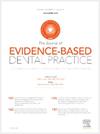牙科病人报告结果(dPROs)在口腔健康预测模型研究中的应用:一项方法学回顾
IF 4
4区 医学
Q1 DENTISTRY, ORAL SURGERY & MEDICINE
引用次数: 0
摘要
目的口腔患者报告结果(dPROs)是口腔保健共同决策的重要指标。本研究旨在评估口腔健康临床预测模型(CPMs)中使用dPROs和dpro相关因素作为预测或预测结果的频率,并确定与CPMs中使用dPROs和/或dpro相关因素相关的变量。方法于2024年5月17日进行PubMed检索,筛选符合条件的研究。纳入了2018年以后发表的旨在利用传统统计技术(如logistic或Cox回归)开发口腔健康cpm的研究。提取并总结了cpm中作为潜在预测因子、最终预测因子和预测结果的dpro及其相关因子。采用Logistic回归分析评估各变量与dpro使用及dpro相关因素之间的相关性。结果共纳入144项研究,其中回顾性研究占88.2%,口腔肿瘤学研究占73.6%。在28项(19.4%)、21项(14.6%)和7项(4.9%)研究中,dpro和/或dpro相关因素分别被用作潜在预测因子、最终预测因子和预测结果。最常用的dPRO作为潜在和最终预测因子是自我报告的口腔面部疼痛,而最常用的dPRO相关因子是自我报告的刷牙情况。最常使用dPRO作为预测结果的是自我报告的口干症,而没有研究使用dPRO相关因素作为预测结果。研究主题与dpro的使用和/或dpro相关因素有统计学显著相关(优势比[or]: 9.98;95%置信区间[CI]: 3.36 29.67;P & lt;. 01)。结论在口腔健康预测模型研究中,dpro及其相关因素很少被用作预测因子或预测结果。口腔肿瘤学以外的牙科领域的研究,如龋齿学和牙周病学,与口腔肿瘤学相比,更有可能使用dpro和/或dpro相关因素。本文章由计算机程序翻译,如有差异,请以英文原文为准。
THE USE OF DENTAL PATIENT-REPORTED OUTCOMES (dPROs) IN PREDICTION MODELING STUDIES IN ORAL HEALTH: A METHODOLOGICAL REVIEW
Objective
Dental patient-reported outcomes (dPROs) are critical indicators of shared decision-making in oral healthcare. This study aimed to assess the frequency of use of dPROs and dPRO-related factors being used as predictors or predicted outcomes in clinical prediction models (CPMs) in oral health, and to identify variables associated with the use of dPROs and/or dPRO-related factors in CPMs.
Methods
A PubMed search was conducted on 17th May, 2024, to identify eligible studies. The studies which aimed to develop CPMs in oral health using traditional statistical techniques (e.g. logistic or Cox regression) and were published from 2018 onwards were included. The dPROs and dPRO-related factors used as potential predictors, final predictors, and predicted outcomes in the CPMs were extracted and summarized. Logistic regression analyses were performed to assess the associations between various variables and the use of dPROs and dPRO-related factors.
Results
A total of 144 studies were included, of which 88.2% were retrospective studies and 73.6% were on oral oncology. dPROs and/or dPRO-related factors were used as potential predictors, final predictors, and predicted outcomes in 28 (19.4%), 21 (14.6%), and 7 (4.9%) studies, respectively. The most frequently used dPRO as both potential and final predictors was self-reported orofacial pain, while the most frequently used dPRO-related factor was self-reported toothbrushing. The most frequently used dPRO as a predicted outcome was self-reported xerostomia, while no studies used dPRO-related factors as outcomes. The study topic was statistically significantly associated with the use of dPROs and/or dPRO-related factors (Odds Ratio [OR]: 9.98; 95% confidence interval [CI]: 3.36 29.67; P < .01).
Conclusions
dPROs and dPRO-related factors were infrequently used as predictors or predicted outcomes in prediction modeling studies in oral health. Studies in dental fields other than oral oncology, such as cariology and periodontology, were more likely to use dPROs and/or dPRO-related factors compared to those in oral oncology.
求助全文
通过发布文献求助,成功后即可免费获取论文全文。
去求助
来源期刊

Journal of Evidence-Based Dental Practice
DENTISTRY, ORAL SURGERY & MEDICINE-
CiteScore
6.00
自引率
16.70%
发文量
105
审稿时长
28 days
期刊介绍:
The Journal of Evidence-Based Dental Practice presents timely original articles, as well as reviews of articles on the results and outcomes of clinical procedures and treatment. The Journal advocates the use or rejection of a procedure based on solid, clinical evidence found in literature. The Journal''s dynamic operating principles are explicitness in process and objectives, publication of the highest-quality reviews and original articles, and an emphasis on objectivity.
 求助内容:
求助内容: 应助结果提醒方式:
应助结果提醒方式:


